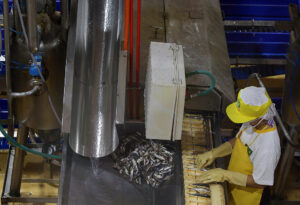




Philippines Trade Update: Trade trajectories trend along
 DOWNLOAD
DOWNLOAD

Policy Rate Updates: Double cut finale
 DOWNLOAD
DOWNLOAD

Monthly Economic Update: One for the road
 DOWNLOAD
DOWNLOAD


April PMI growth slowest in 8 months

PHILIPPINE MANUFACTURING activity eased to an eight-month low in April as new orders and output both rose at a slower pace, S&P Global said.
The S&P Global Philippines Manufacturing Purchasing Managers’ Index (PMI) reading stood at 51.4 in April, down from 52.5 in March.
This was the lowest PMI reading in eight months or since the 51.2 posted in August last year.
 “The start of the second quarter signaled a loss of momentum across the Filipino manufacturing sector. The headline PMI was at an eight-month low, with both new orders and output growing at much softer rates,” Maryam Baluch, economist at S&P Global Market Intelligence, said in a statement.
“The start of the second quarter signaled a loss of momentum across the Filipino manufacturing sector. The headline PMI was at an eight-month low, with both new orders and output growing at much softer rates,” Maryam Baluch, economist at S&P Global Market Intelligence, said in a statement.
April marked the 15th straight month that the PMI reading was above the 50 mark, which denotes improvement in operating conditions. A reading below 50 signals deterioration.
The headline PMI measures manufacturing conditions through the weighted average of five indices: new orders (30%), output (25%), employment (20%), suppliers’ delivery times (15%) and stocks of purchases (10%).
Based on the latest PMI reading, the Philippines ranked fourth out of five Association of Southeast Asian Nations (ASEAN) member countries. It lagged behind Thailand (60.4), Myanmar (57.4), and Indonesia (52.7), but ahead of Malaysia (48.8).
“Contributing to the softer uptick in business conditions across the Filipino manufacturing sector was a relatively muted upturn in new business. The rate of growth was the weakest in the current eight-month sequence of expansion amid reports of increased market competition and softer demand,” S&P Global said.
Firms’ output also expanded at its weakest rate in six months, it added.
Ms. Baluch noted the data reflected a shift in demand patterns as new export orders jumped at the fastest pace in nearly two years, which helped boost total new sales.
“April data suggested much sturdier demand for Filipino manufactured goods from foreign markets, as new export orders grew at a strong pace. In fact, the rate of expansion quickened to the joint-fastest in nearly two years,” S&P Global said.
Employment in Philippine manufacturing firms dropped for a third straight month, amid widespread reports of resignations.
“Though the rate of job shedding was marginal, firms linked this to difficulties in retaining staff. Moreover, alongside reports of staff shortages, firms also noted that material scarcity and delivery delays resulted in a second successive month of backlog accumulation,” S&P Global said.
Purchasing activity went up for an eighth consecutive month.
“According to anecdotal evidence, the rise in new business supported growth in purchasing activity. That said, the respective seasonally adjusted index ticked down further from January’s recent high, and signaled the slowest rate of growth in 2023 so far,” it said.
S&P Global noted price pressures cooled further in April.
“While operating expenses grew at a solid rate, the pace of inflation was the weakest in two-and-a-half years. Reflecting softer hikes in cost burdens, manufacturers raised their selling prices at the slowest pace in 28 months,” Ms. Baluch said.
Manufacturing firms are still upbeat on expectations of more new orders and improved demand conditions in the next 12 months.
“Looking ahead, manufacturers across the Philippines remained largely optimistic, as the degree of confidence in the year-ahead outlook for output reached a three-month high. That said, the degree of confidence was weaker than the series average. Furthermore, our latest forecast expects growth in industrial production to moderate to 5% in 2023,” Ms. Baluch added.
ING Bank N.V. Manila Senior Economist Nicholas Antonio T. Mapa said that the Philippine manufacturing sector is still expanding, but there is a trend of moderating growth.
“The slowdown reflects our expectation that economic activity is moderating, perhaps as revenge spending fades and inflation bites,” Mr. Mapa said in a Viber message.
Rizal Commercial Banking Corp. Chief Economist Michael L. Ricafort said the slower factory output growth may be attributed to elevated inflation and higher interest rates “that partly weighed on demand and other business/economic activities.”
April inflation likely settled at 7%, according to a BusinessWorld poll of 14 analysts. This is near the upper end of the 6.3-7.1% forecast range by the central bank for the month.
Inflation had averaged 8.3% in the first quarter.
Meanwhile, Mr. Ricafort said factory activity in the next few months could be supported by the reopening of China, one of the biggest trading partners of the Philippines.
“Easing trend on year-on-year inflation would also support some pickup in manufacturing activities for the coming months, on top of the further reopening of the economy towards greater normalcy,” he added. — By Luisa Maria Jacinta C. Jocson, Reporter
This article originally appeared on bworldonline.com





 By BusinessWorld
By BusinessWorld